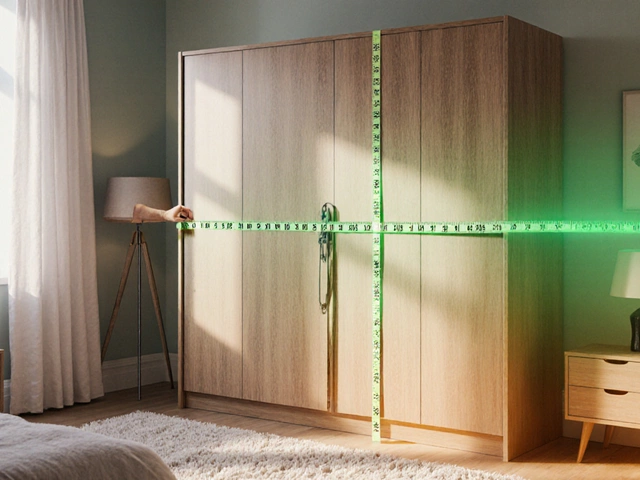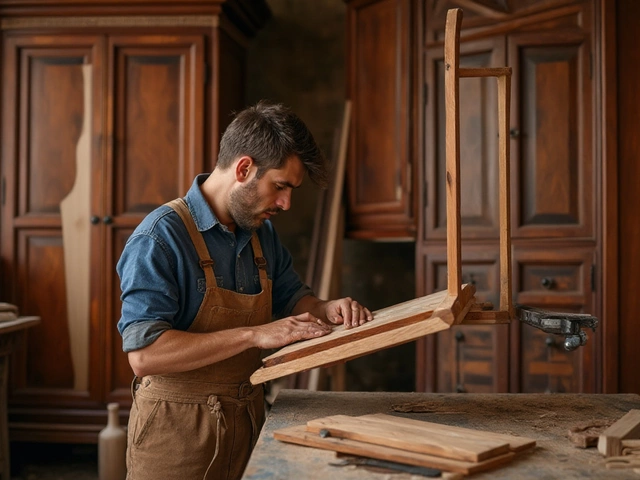 12
Jul,2025
12
Jul,2025
Sitting on a sofa bed can sometimes feel like being stuck between a rock and a hard place—literally. You want your living room to be a chill zone, but sofa beds love to remind you they’re part-time sleepers, part-time pranksters. That tell-tale sag, jolting metal bar, or those oddly unsupportive cushions aren't anyone’s idea of comfort. But believe it or not, making a sofa bed genuinely comfortable to sit on isn’t some impossible quest. With the right tweaks, you can turn yours into a spot where you’ll actually want to spend your Sunday afternoons.
Understanding the Sofa Bed Struggle
The biggest issue with sofa beds is simple: they’re designed to serve two purposes, but rarely ace either. Most sofa beds are built with fold-out mechanisms, which means there’s a frame and a thin mattress hiding below those cushions. Manufacturers try to keep it light and slim so you can actually lift and unfold it, and that means sacrifices. Thinner padding, more rigid supports, and awkward bars underneath all make their mark. It’s no wonder many sofa beds develop crater-like sitting spots or that infamous center ridge you can feel in your spine.
According to surveys by consumer groups, more than 60% of sofa bed owners say they mostly avoid sitting on it for long periods, preferring it just as a backup bed. Experts point out that the culprit is often the internal bar that supports the mattress, which transfers pressure straight to the seat cushions. Even high-end models sometimes fall short—so don’t feel bad if you’re not lounging on a designer masterpiece.
Most sofa beds use polyfoam padding, which breaks down faster than the high-resilience foam you’d find in regular sofas. This means your sofa bed can start to sag after just a year or two of use, especially if you’ve hosted a bunch of guests—or if it doubles as your movie night HQ. Some savvy brands now offer memory foam or hybrid mattresses, but even these need extra help if you want real comfort when sitting, not just sleeping.
Let’s talk about those cushions. The seat cushions on sofa beds are usually thinner—sometimes just 3-4 inches. Compare that to a regular couch, where cushions can be double or triple that. Thinner cushions mean less support for your hips, less padding between you and the frame, and way more fidgeting to find a cozy spot. And the upholstery? It’s usually fitted super tight, which looks neat but doesn’t help much with day-to-day softness.
So, the struggle is real—but that just means there’s plenty of room to upgrade. Whether your sofa bed is the center of your home or just an extra seat in the guest room, a few smart fixes can make a shocking difference.
Practical Fixes You Can Do Today
Let’s get straight to the fixes. The goal: better support, cushier feel, and a spot that feels as close as possible to your favorite couch. Start with the most basic: extra cushions. Grabbing a couple of thick, high-density foam seat pads can do wonders. Mix in some feather or fiber-filled throw pillows, and you’ll instantly boost comfort without any tools or fuss. Try arranging them vertically behind your back for support, and layer a couple on the seat to soften the pressure from those sneaky bars.
An underrated hack: a memory foam mattress topper. Cut it to fit the size of your seat, place it under the sofa bed’s cushions, and enjoy a new layer of cozy. Look for toppers at least 2 inches thick—the thicker, the better. This works by absorbing the pressure from the underlying bars and spreading your weight, so you don’t feel like you’re sitting on a jungle gym. Some people even use old camper pads or yoga mats for a quick fix—cut them to size and stack as needed.
If your sofa bed has a removable mattress, investing in a high-quality, thicker replacement can be a game-changer. Newer sofa bed mattresses use gel-infused memory foam or hybrid constructions, which keep their bounce longer and don’t get as hot as old-school foam. These mattresses are designed to deal with folding and unfolding, just as regular sleeper sofas demand, so they won’t turn lumpy after a few uses.
Here’s a tip most folks miss: check the support structure under the mattress, especially if it’s a metal grid. Solid support boards, plywood panels, or even a simple slat system can stop sagging. Home centers sell slat kits for cheap, and you can customize them to fit your sofa bed frame. Just slip one or two sturdy boards under the mattress—this spreads out your weight and takes the load off that awful center bar. A lot of people report feeling the difference right away, especially if your current setup is just thin metal mesh.
Don’t forget about fabric. Throwing a thick, quilted cover or blanket over your sofa bed cushions not only adds softness but also keeps body heat from sinking straight into the foam (no one enjoys that chill halfway through a movie). There are even custom sofa bed covers out there, stuffed with polyester or down-alternative filling, specifically made for more relaxing lounging.
If you’re the DIY type, consider sewing a custom slipcover with batting inside. Add a layer of old mattress pad or comforter, sew it into a slipcover, and you’ve basically built yourself a deluxe seat topper. Make sure whatever you use doesn’t interfere with your sofa bed opening and closing, though—test it out before committing to anything permanent.
For the truly dedicated, swapping out old foam in your seat cushions for higher-density foam is absolutely worth it. Many upholstery shops can cut custom foam inserts for you, so bring your cushion covers and get a perfect fit. Not only do you get better comfort, but you can also pick firmer or softer foam to match your chill style.
- Add feather or down throw pillows for instant soft support.
- Use a 2" or thicker memory foam topper under seat cushions for pressure relief.
- Slip in slats or plywood boards under the mattress to stop sagging.
- Upgrade your sofa bed mattress to a hybrid or memory foam for better all-around use.
- Try quilted covers or slipcovers with added filling to mimic plush upholstery.
- Check your seat foam—replace with higher-density options if it feels flat.
- Get creative with yoga mats or camping pads for a quick, semi-custom upgrade.

Data Speaks: Comfort Levels and Fix Effectiveness
Sometimes it feels like everyone online is promising comfort hacks that don’t actually work. But here’s some good news: there’s real data on what helps most. According to a 2023 home furnishings survey, nearly 77% of people who tried a foam mattress topper under their sofa bed cushions said they’d “definitely recommend it” to friends. Upgrading the original mattress or cushion foam got a thumbs-up from 66% of respondents for noticeable comfort improvements.
Here’s a helpful breakdown of what people report after different fixes:
| Fix | Reported Comfort Increase (%) | Works for Sitting? | Works for Sleeping? |
|---|---|---|---|
| Foam Mattress Topper | 77 | Yes | Yes |
| Extra Cushion Layers | 68 | Yes | Partial |
| Support Board/Slats | 63 | Yes | Yes |
| High-Density Foam Inserts | 66 | Yes | Yes |
| Quilted/fiber Cover | 59 | Yes | No |
A lot of folks are surprised to learn that support fixes (like slats or boards) have a bigger impact on sitting comfort than they expect. If you constantly feel the frame digging in, or if you and your guests tend to slide into a sinking middle spot, this quick fix can make your sofa bed feel closer to a regular couch without much cash or effort.
If your sofa bed is brand new, sticking with extra cushions and simple toppers might be enough to keep that out-of-the-box comfort going strong. But most people notice a real drop-off after a couple of years—and that’s when the bigger upgrades pay off.
If you have allergies or asthma, hypoallergenic cushion inserts and covers are your friend. Dust, dander, and polyester-based fabrics can get trapped in sleeper sofas pretty easily, so look for washable, allergen-resistant materials.
There’s also a small but loyal community of people who swear by gel seat pads—the kind truck drivers use for long hauls. Toss one on your sofa bed during gaming sessions or when binging a show, and your lower back will thank you. Some of these pads even use air pockets, helping circulation and stopping that “pins and needles” feeling.
Of course, seat height matters too. Many sofa beds sit lower to the ground than traditional couches, because of the mattress folding mechanism. If you find your knees riding higher than your hips, consider adding risers to your sofa bed’s feet, or even sliding a wooden wedge under each leg to boost height by an inch or two (just check stability, especially if you have kids or heavier guests!).
Long-Term Habits and Maintenance Tips
So, you’ve got the instant upgrades and you’re enjoying a more livable sofa bed. Now what? A few easy habits can keep things comfy down the road. First, flip and rotate any removable seat and back cushions every few weeks, just like you would with a mattress. This prevents permanent super-saggy spots and helps foam or fiber fillings keep their shape.
Give your sofa bed a deep clean each season. Take off slipcovers, vacuum under and behind the cushions, and wash any blankets or toppers you use. Dust and crumbs are comfort killers—plus, a clean sofa bed just feels fresher than one that’s hiding last month’s popcorn under the cushions.
If you start to notice your foam getting mushy, don’t wait until it’s totally lifeless. Replacing foam inserts is cheaper and easier than you’d think. Upholstery shops and online cushion makers can usually ship a new insert to size in under a week. Pair that with a durable cover, and your sofa bed gets a major comfort upgrade with minimal downtime.
If kids or pets are regulars on your sofa bed, consider waterproof or washable covers. Accidents happen, and nothing ruins sitting comfort like stubborn stains or weird odors. There are loads of stylish options out there, so you don’t have to sacrifice looks for practicality.
Some sofa beds allow you to adjust spring tension or add more support to the folding mechanism. Check your model’s online manual; you might be able to fine-tune it for a firmer sit by tweaking a few bolts or adding stronger springs. The effect varies by brand, but this overlooked trick can make a difference for chronic sagging issues.
Check the frame for loose screws and bolts every few months. A wobbly frame not only annoys but also adds pressure points under your sofa bed comfort setup. Tighten things up with a standard Phillips screwdriver, and lubricate folding hinges if they creak or stick—this helps the bed fold out smoothly and the seat stay level.
Lastly, don’t ignore airflow. If your sofa bed is near a window, rotate which side gets the most sun to keep foam from degrading unevenly. If you have a humid room, run a dehumidifier—trapped moisture can sink into cushions and mattress padding, making them moldy and flat over time.
Get into these habits, and you’ll easily stretch the life and comfort of your sofa bed by years. Plus, a well-cared-for sleeper always looks better, no matter how much you use it to kick back or crash for a nap.




